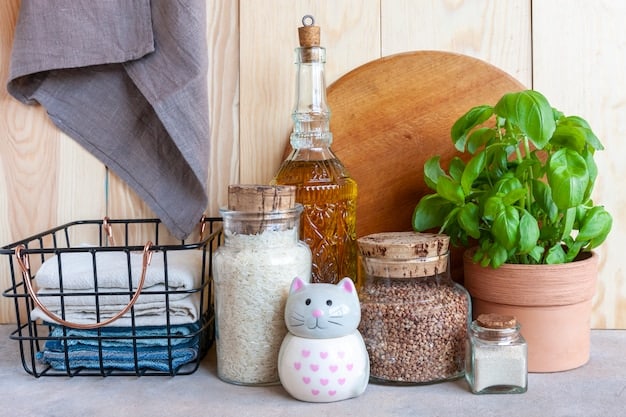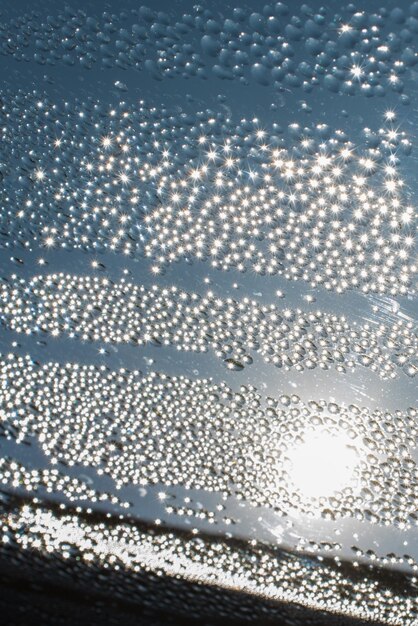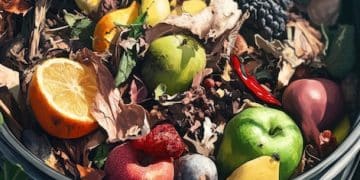Eco-Friendly Cleaning Products: Safe and Sustainable Home Alternatives

Embracing eco-friendly cleaning products offers a safer and more sustainable approach to home maintenance, reducing chemical exposure while protecting the environment from harmful pollutants.
In an era increasingly defined by environmental consciousness, the choices we make within our homes profoundly impact our planet. The shift towards Eco-Friendly Cleaning Products: Safe and Sustainable Alternatives for Your Home represents more than just a trend; it’s a fundamental reconsideration of our domestic routines, aiming to foster healthier living environments while safeguarding ecological integrity.
The Imperative for Eco-Friendly Cleaning
The transition to eco-friendly cleaning isn’t merely about personal preference; it’s a pressing necessity driven by mounting evidence of the adverse effects of conventional cleaning agents. Traditional products often contain harsh chemicals that contribute to indoor air pollution, trigger allergic reactions, and pose significant risks to both human health and aquatic ecosystems upon disposal.
Understanding these impacts is the first step towards embracing alternatives. Many conventional cleaners release volatile organic compounds (VOCs) into the air, which can cause respiratory issues, headaches, and even long-term health complications. Furthermore, their ingredients, such as phosphates and ammonia, can pollute waterways, harming marine life and disrupting delicate ecological balances.
Hidden Dangers in Conventional Cleaners
Many household cleaning products, seemingly innocuous, harbor a cocktail of chemicals with documented health risks. Decoding product labels can be challenging, as regulations often permit manufacturers to withhold certain ingredient lists deemed “trade secrets.” This opacity makes informed consumer choices difficult.
- Phthalates: Often found in scented products, linked to endocrine disruption.
- Chlorine bleach: A powerful disinfectant that can emit dangerous fumes when mixed with other cleaners.
- Ammonia: Common in glass cleaners, can irritate respiratory passages.
- Quaternary Ammonium Compounds (Quats): Found in disinfectants, potentially contributing to antibiotic resistance and asthma.
These substances, while effective at their stated purpose, carry significant collateral damage. The long-term accumulation of exposure, particularly in poorly ventilated spaces, amplifies their impact. Recognizing this provides a strong impetus for seeking out alternatives that don’t compromise health for cleanliness.
The environmental footprint of manufacturing, transporting, and disposing of these chemical-laden products further compounds the problem. From reliance on fossil fuels to the creation of non-biodegradable waste, the lifecycle of conventional cleaners stands in stark contrast to the principles of sustainability that eco-friendly options champion.
Ultimately, choosing eco-friendly cleaning is about harm reduction. It’s about consciously opting for products that fulfill their purpose without introducing toxins into our homes or the broader environment. This proactive stance contributes to a healthier indoor climate and plays a small yet significant role in global ecological preservation.
Defining Eco-Friendly Cleaning Products
What exactly defines an “eco-friendly” cleaning product, and how can consumers discern genuine green options from mere greenwashing? The term itself implies a product designed to minimize negative impacts on human health and the environment. This often translates to biodegradable ingredients, non-toxic formulations, reduced packaging, and sustainable manufacturing practices.
It’s crucial to look beyond marketing claims and delve into specific attributes. Certification labels from reputable organizations, such as the EPA’s Safer Choice program or Ecocert, serve as reliable indicators. These certifications ensure products meet stringent standards for ingredient safety, environmental performance, and manufacturing transparency.
Key Characteristics of Truly Green Products
Beyond vague “natural” claims, specific indicators signal a product’s genuine eco-friendliness. These characteristics extend beyond the ingredients to encompass the entire product lifecycle, from sourcing to disposal.
- Biodegradable Ingredients: Components that naturally break down without harming ecosystems.
- Non-Toxic Formulas: Free from harsh chemicals, VOCs, phosphates, chlorine, and synthetic fragrances.
- Reduced Packaging: Often utilize recycled content, concentrated formulas, or offer refill options.
- Cruelty-Free Testing: No animal testing involved during any stage of product development.
Furthermore, sustainable sourcing of ingredients, minimal water usage in manufacturing, and a commitment to fair labor practices within the supply chain are often hallmarks of truly eco-conscious brands. A holistic approach considers the entire impact, not just the end product’s chemical makeup.
Many green cleaners leverage the power of plant-based ingredients, such as citrus extracts, vinegar, and essential oils, for their cleaning and antiseptic properties. These natural alternatives often perform just as effectively as their chemical counterparts, without the associated health and environmental risks.
The rise of concentrated solutions and refill programs also significantly reduces plastic waste, a major environmental concern. Consumers can purchase reusable bottles and simply replenish their cleaning products using bulk options or smaller, recyclable concentrate packets, drastically cutting down on single-use plastics.

Ultimately, identifying eco-friendly cleaning products requires a discerning eye and a willingness to investigate beyond the surface. Prioritizing transparency, certifications, and a commitment to comprehensive sustainability will lead consumers to genuinely beneficial alternatives.
DIY Eco-Cleaning Solutions: Empowering Your Home
One of the most effective and empowering ways to adopt eco-friendly cleaning practices is to create your own solutions. DIY cleaning significantly reduces waste, eliminates exposure to unknown chemicals, and is remarkably cost-effective. Common household ingredients like vinegar, baking soda, lemon, and essential oils form the foundation of myriad potent yet gentle cleaners.
The beauty of DIY solutions lies in their simplicity and versatility. A basic understanding of the properties of these core ingredients allows for the creation of cleaners tailored to specific needs, from all-purpose sprays to abrasive scrubs and glass cleaners, all without a single artificial additive.
Essential Ingredients for Homemade Cleaners
Venturing into DIY cleaning doesn’t require a chemistry degree or an extensive shopping list. A few fundamental, readily available ingredients can tackle most household cleaning tasks effectively, proving that sometimes, less truly is more, especially when it comes to chemical compounds.
- White Vinegar: A natural disinfectant and deodorizer, excellent for cutting grease and grime.
- Baking Soda: A mild abrasive, scourer, and deodorizer, perfect for sinks and tubs.
- Lemon Juice: Acts as a natural bleach, stain remover, and provides a fresh scent.
- Castile Soap: A concentrated, plant-based soap that can be used for various cleaning tasks.
Combining these simple ingredients unlocks a powerful arsenal against dirt and germs. For instance, a mixture of white vinegar and water with a few drops of essential oil makes an excellent all-purpose spray. Baking soda can be sprinkled on surfaces as a mild abrasive before scrubbing, or used to absorb odors in refrigerators and carpets.
Beyond the cost savings, making your own cleaners gives you complete control over the ingredients, ensuring that no hidden toxins or irritants enter your home. This level of transparency is virtually impossible to achieve with store-bought products, even those marketed as “green.”
Furthermore, reusing spray bottles and containers for your homemade solutions significantly reduces plastic consumption. This closed-loop system is a prime example of sustainable living in action, minimizing waste at every turn and promoting a circular economy within your home.
Embracing DIY eco-cleaning solutions is not just about cleaning; it’s about reclaiming agency over your home environment, fostering a deeper connection to sustainable practices, and enjoying the peace of mind that comes from knowing exactly what you’re using.
Navigating the Market: Commercial Eco-Friendly Brands
While DIY solutions are powerful, the market for commercial eco-friendly cleaning products has also expanded significantly, offering convenient, effective alternatives for those who prefer ready-made options. However, the sheer volume of choices can be overwhelming, and distinguishing truly sustainable brands from those engaging in “greenwashing” – misleading claims about environmental practices – is crucial.
The key lies in informed purchasing. Look for brands that are transparent about their ingredients, manufacturing processes, and supply chains. Certifications from third-party organizations are invaluable here, as they provide independent verification of a product’s environmental and health claims.
What to Look for in Commercial Green Cleaners
When standing in the cleaning aisle, a discerning eye for specific details can help differentiate truly eco-conscious brands. Move beyond attractive packaging and buzzwords to focus on tangible evidence of sustainability and safety, ensuring your purchase aligns with your values.
- Ingredient Transparency: Companies should clearly list all ingredients, avoiding vague terms.
- Third-Party Certifications: Look for labels like EPA Safer Choice, Ecologo, or Green Seal. These are independently verified.
- Minimal and Recycled Packaging: Prioritize products in post-consumer recycled plastic or concentrated forms.
- Company Ethics: Research the brand’s overall commitment to sustainability, fair labor, and animal welfare.
Many reputable eco-friendly brands go beyond simply omitting harsh chemicals. They invest in renewable energy for their manufacturing facilities, implement closed-loop systems to minimize waste, and contribute to environmental conservation efforts. This holistic approach reflects a genuine commitment to sustainability.
It’s also worth investigating concentrated formulas. These products use less water, reducing shipping weight and thus carbon emissions. They also typically come in smaller packaging, further minimizing waste. Consumers simply dilute them at home, saving both money and resources.
Furthermore, consider brands that offer refill options or subscription services for their products. This often involves purchasing one reusable container and then refilling it with concentrated pouches or tablets, drastically cutting down on single-use plastic waste over time.
By being a conscious consumer, you not only make a healthier choice for your home but also send a clear message to manufacturers that demand for truly sustainable products is growing, encouraging more companies to adopt responsible practices.
The Benefits Beyond Cleanliness: Health and Environmental Impact
The adoption of eco-friendly cleaning products extends far beyond merely achieving a spotless home. The profound benefits ripple outwards, impacting not just the immediate health of your household but also contributing significantly to broader environmental preservation efforts. Understanding these multifaceted advantages reinforces the value of making this switch.
From improving indoor air quality to safeguarding precious ecosystems, the positive ripple effect is undeniable. This holistic perspective makes the choice for sustainable cleaning not just a practical one, but an ethical commitment to future generations.
A Breath of Fresh Air: Health Advantages
One of the most immediate and tangible benefits of eco-friendly cleaning is the dramatic improvement in indoor air quality. Traditional cleaners often release a cocktail of volatile organic compounds (VOCs) and other irritants into the air, leading to a range of health issues. By eliminating these toxins, you create a safer breathing environment, especially crucial for vulnerable populations.
- Reduced Respiratory Issues: Fewer airborne irritants mean less risk of asthma, allergies, and chemical sensitivities.
- Elimination of Skin Irritation: Harsh chemicals can cause contact dermatitis; natural alternatives are gentler on skin.
- Safer for Children and Pets: Minimized exposure risks for those most likely to come into contact with cleaned surfaces.
- Lowered Risk of Long-Term Illnesses: Avoiding carcinogens and endocrine disruptors reduces cumulative health risks.
The absence of strong chemical odors is another noticeable improvement, often replaced by subtle, natural scents from essential oils or no scent at all. This creates a much more pleasant and less oppressive atmosphere within the home, a subtle but significant enhancement to daily living.
For families with young children or pets, the peace of mind that comes with knowing surfaces are free from toxic residues is invaluable. Babies crawling on floors and pets licking surfaces are particularly susceptible to chemical exposure, making non-toxic cleaners a paramount choice for their safety.
Beyond direct exposure, the manufacturing process of chemical cleaners also poses occupational health risks for workers. By supporting brands committed to sustainable and safe production methods, consumers contribute to healthier working conditions across the industry.

Protecting Our Planet: Environmental Impact
The ecological advantages of eco-friendly cleaning products are far-reaching, addressing multiple facets of environmental degradation. From ingredient sourcing to wastewater disposal, every stage of the product lifecycle is designed to minimize harm, contributing to a healthier planet for all.
- Waterway Protection: Biodegradable ingredients prevent pollution of rivers, lakes, and oceans.
- Reduced Air Pollution: Lower VOC emissions contribute to cleaner outdoor air as well.
- Conservation of Resources: Sustainable sourcing and minimal packaging reduce demand for virgin materials.
- Waste Reduction: Refillable systems and concentrated formulas drastically cut down on plastic waste.
When chemicals from conventional cleaners are rinsed down the drain, they enter municipal wastewater systems. Many of these substances are not fully removed by treatment plants and eventually make their way into natural water bodies, causing dead zones, algal blooms, and toxicity to aquatic life.
The manufacturing and transportation of chemical cleaning products also contribute to carbon emissions. Eco-friendly brands often prioritize local sourcing, utilize renewable energy, and design lightweight packaging to reduce their carbon footprint, addressing climate change concerns.
Furthermore, supporting companies dedicated to ethical and sustainable practices drives innovation in the green chemistry sector. This encourages research and development of even safer and more effective plant-based and mineral-derived cleaning technologies, fostering a virtuous cycle of environmental responsibility.
Choosing eco-friendly cleaning products is a tangible way for individuals to participate in environmental stewardship, demonstrating that everyday consumer choices can aggregate into significant positive change for both immediate indoor environments and the global ecosystem.
Overcoming Challenges and Making the Switch
Making the switch to eco-friendly cleaning products, whether homemade or commercially bought, can seem daunting initially, but the challenges are often minor compared to the benefits. Common concerns include perceived effectiveness, cost, and availability. Addressing these can smooth the transition.
It’s important to approach the change with an open mind and a willingness to experiment. The landscape of green cleaning has evolved significantly, offering highly effective solutions that often rival or surpass their chemical counterparts, dispelling outdated notions of efficacy.
Common Misconceptions and Practical Tips
Misconceptions often deter people from switching to eco-friendly cleaners, primarily revolving around effectiveness and cost. However, with the right approach and a few practical tips, these hurdles are easily overcome, revealing the true potential of sustainable cleaning.
- Effectiveness: Many assume natural cleaners are less potent. In reality, modern green formulations are highly effective, and DIY options like vinegar and baking soda have proven cleaning power.
- Cost: While some commercial green cleaners might have a higher upfront cost, concentrates and DIY solutions are often more economical in the long run.
- Availability: Eco-friendly products are increasingly available in mainstream supermarkets, not just specialty stores.
- Learning Curve: Adapting to new products or making your own might require a small learning curve, but online resources and recipes make it simple.
Starting small can be an effective strategy. Begin by replacing just one or two of your most frequently used cleaners, like an all-purpose spray or dish soap, with an eco-friendly alternative. Once you experience the benefits, expanding to other areas of the home becomes a natural progression.
Reading reviews and seeking recommendations from friends or online communities can also help identify effective products and trustworthy brands, reducing the trial-and-error phase. Many eco-conscious consumers are eager to share their successes and insights.
For DIY enthusiasts, dedicating a small space in a utility closet or under a sink for ingredients and reusable bottles can make the process more organized and convenient. Pre-mixing common solutions in labeled bottles ensures they are ready for immediate use, mimicking the convenience of store-bought options.
Ultimately, transitioning to eco-friendly cleaning is a journey. It represents a conscious decision to prioritize health, sustainability, and responsible consumption, transforming a routine household chore into an act of environmental stewardship.
Future Trends in Sustainable Cleaning
The landscape of eco-friendly cleaning products is continually evolving, driven by innovation, growing consumer demand, and increasing environmental awareness. Looking ahead, several trends are poised to shape the future of sustainable home maintenance, promising even greater efficacy and environmental benefits.
These emerging trends point towards a future where cleaning is not only effective but also seamlessly integrated into a broader circular economy, minimizing waste and maximizing resource efficiency. The industry is moving beyond simply “less toxic” to truly “regenerative” solutions.
Innovations and Emerging Technologies
The push for true sustainability is fostering exciting developments in cleaning technology. Research into bio-based ingredients and advanced delivery systems is paving the way for products that are both highly effective and environmentally benign. The future of cleaning is rooted in science that respects nature.
- Probiotic Cleaning: Utilizing beneficial microorganisms to break down dirt and odors at a microscopic level, offering long-lasting cleanliness.
- Water-Soluble Pods and Strips: Concentrated, dissolvable forms of cleaning agents that eliminate plastic packaging entirely.
- Upcycled Ingredients: Creating cleaning agents from waste products of other industries, reducing overall material consumption.
- Smart Dispensing Systems: Automated or app-controlled systems that precisely measure and dispense concentrates, minimizing waste and ensuring optimal use.
The concept of “cleaning as a service,” where companies provide reusable containers and refill services directly to consumers’ homes, is also gaining traction. This model significantly reduces individual plastic consumption and simplifies the eco-friendly transition for busy households.
Furthermore, advances in material science are leading to the development of self-cleaning surfaces and antimicrobial coatings that reduce the need for frequent chemical cleaning. These passive solutions contribute to long-term hygiene with minimal environmental impact.
The integration of artificial intelligence and machine learning in product development allows manufacturers to optimize formulas for maximum effectiveness with the fewest, safest ingredients. This data-driven approach promises a new era of precision eco-cleaning.
These innovations underscore a paradigm shift: cleaning is becoming less about harsh chemical warfare and more about smart, synergistic solutions that work with natural processes. The future of home cleaning is clean, green, and incredibly clever.
| Key Aspect | Brief Description |
|---|---|
| 🌿 Health Benefits | Reduces exposure to harsh chemicals, improving indoor air quality and reducing health risks. |
| 🌎 Environmental Impact | Protects waterways, reduces air pollution, conserves resources, and minimizes plastic waste. |
| 💰 Cost-Effectiveness | DIY options are very cheap; commercial concentrates offer long-term savings. |
| 🧪 Transparency & Certifications | Look for clear ingredient lists and trusted third-party certifications (e.g., EPA Safer Choice). |
Frequently Asked Questions About Eco-Friendly Cleaning
Absolutely. Modern eco-friendly cleaning products leverage advanced plant-based chemistry and natural minerals to deliver highly effective cleaning power. Many formulations are specifically designed to tackle tough grime, disinfect surfaces, and leave a spotless finish without the need for harsh chemicals, often outperforming traditional options in safety and effectiveness.
Common and highly effective key ingredients for homemade eco-friendly cleaners include white vinegar, baking soda, lemon juice, and castile soap. These versatile components can be combined in various ways to create all-purpose cleaners, scrubs, glass cleaners, and degreasers, offering natural and powerful cleaning solutions for almost any household task.
To identify genuine eco-friendly brands, look for third-party certifications such as EPA Safer Choice, Ecologo, or Green Seal. These certifications signify adherence to strict environmental and health standards. Additionally, prioritize brands with transparent ingredient lists, minimal and recycled packaging, and a clear commitment to sustainable practices beyond just the product formulation.
Switching to eco-friendly cleaning significantly improves indoor air quality by reducing exposure to volatile organic compounds (VOCs) and other irritants found in conventional cleaners. This can lead to decreased respiratory issues like asthma and allergies, reduce skin irritation, and contribute to a healthier home environment for all residents, especially children and pets.
While some commercial eco-friendly products might have a slightly higher initial price, they often come in concentrated forms that last longer, leading to cost savings over time. Furthermore, homemade cleaning solutions using ingredients like vinegar and baking soda are exceptionally inexpensive, making eco-friendly cleaning a highly economical choice in the long run.
Conclusion
The journey towards a home cleaned with eco-friendly products is a testament to a growing collective awareness about health, sustainability, and responsible living. It moves beyond merely scrubbing surfaces to embrace a philosophy that values well-being and ecological balance. By choosing natural alternatives, whether through DIY concoctions or thoughtfully selected commercial brands, we actively contribute to healthier indoor environments, cleaner waterways, and a reduced carbon footprint. This shift is not just about changing products; it’s about changing habits, fostering a conscious mindset that recognizes the interconnectedness of our daily choices with the welfare of the planet. As innovation continues to make green cleaning more accessible and effective, embracing these safe and sustainable alternatives becomes an increasingly effortless and impactful step towards a truly clean future.





